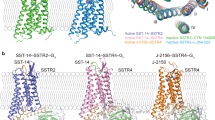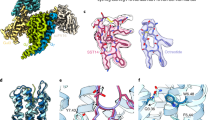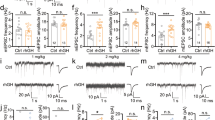Abstract
Although somatostatin was originally identified in the hypo-thalamus as a tetradecapeptide (SRIF or S-14)1, subsequent studies have revealed that tissue somatostatin is heterogeneous comprising in addition to S-14 two larger forms with molecular wieghts (Mrs) of 10,000–15,000 and 3,000 (refs 2–7). Recently a 28-amino acid peptide (somatostatin-28, S-28)—a 14-amino acid N-terminal extension of S-14—has been isolated from mammalian gut and hypothalamus8–10. Synthetic S-28 (Mr 3,160) has been shown to correspond to the 3,000-Mr SLI species found in most tissues5 and to exhibit greater potency than S-14 for inhibiting both endocrine (growth hormone, insulin, glucagon)11,12 and exocrine (pancreatic enzymes and bicarbonate) secretion13. It is not clear whether S-28 exerts similar effects to S-14 on central nervous system functions14 nor whether the S-14-like effects of S-28 are mediated through its conversion to S-14 or through direct action on the recently characterized S-14 receptors of rat brain and pituitary membranes15,16. We suggest here that the greater potency of S-28 for inhibiting growth hormone secretion is because it binds to pituitary S-14 receptors with 3.2-fold higher affinity than does S-14. Furthermore in the central nervous system, S-28 has a lower affinity than S-14 for the receptors, indicating that it is less potent than S-14 in regulating brain functions. Receptor binding of S-28 in both pituitary and brain occurred directly without significant conversion to S-14, suggesting that S-28 is a true S-14 receptor agonist but possesses distinct tissue specificities.
This is a preview of subscription content, access via your institution
Access options
Subscribe to this journal
Receive 51 print issues and online access
$199.00 per year
only $3.90 per issue
Buy this article
- Purchase on SpringerLink
- Instant access to full article PDF
Prices may be subject to local taxes which are calculated during checkout
Similar content being viewed by others
References
Brazeau, P. et al. Science 179, 77–79 (1973).
Patel, Y. C. & Reichlin, S. Endocrinology 102, 523–530 (1978).
Zyznar, E. S., Conlon, J. M., Schusdziarra, V. & Unger, R. H. Endocrinology 105, 1426–1431 (1979).
Spiess, J. & Vale, W. Biochemistry 19, 2861–2866 (1980).
Patel, Y. C., Zingg, H. H., Fitz-Patrick, D. & Srikant, C. B. in Gut Hormones 2nd edn (eds Bloom, S. R. & Polak, J. M.) 339–349 (Churchill Livingstone, Edinburgh, 1981).
Patzelt, C., Tager, H. S., Carrol, R. J. & Steiner, D. F. Proc. natn. Acad. Sci. U.S.A. 77, 2410–2414 (1980).
Lauber, M., Gamier, M. & Cohen, P. Proc. natn. Acad. Sci. U.S.A. 76, 6004–6008 (1979).
Pradayrol, L., Jornvall, H., Mutt, V. & Ribet, A. FEES Lett. 109, 55–58 (1980).
Schally, A. V. et al. Proc. natn. Acad. Sci. U.S.A. 77, 4489–4493 (1980).
Bohlen, P. et al. Biochem. biophys. Res. Commun. 96, 725–734 (1980).
Brazeau, P. et al. Regulatory Peptides 1, 255–264 (1981).
Meyers, C. A., Murphy, W. A., Redding, T. W., Coy, D. H. & Schally, A. V. Proc. natn. Acad. Sci. U.S.A. 77, 6171–6174 (1980).
Sussini, C., Esteve, J. P., Vaysse, N., Pradayrol, L. & Ribet, A. Gastroenterology 78, 720–724 (1980).
Kastin, A. J., Coy, D. H., Jacquet, Y., Schally, A. V. & Plotnikoff, N. P. Metabolism 27, Suppl. 1, 1247–1252 (1978).
Srikant, C. B. & Patel, Y. C. Proc. natn. Acad. Sci. U.S.A. 78, 3930–3934 (1981).
Srikant, C. B. & Patel, Y. C. Endocrinology 108, 341–343 (1981).
Srikant, C. B. & Patel, Y. C. Prog. 63rd a. Meet. U.S. Endocrine Soc. 85 (1981).
Srikant, C. B. & Patel, Y. C. Endocrinology (submitted).
Zingg, H. H. & Patel, Y. C. Life Sci. (submitted).
Zingg, H. H. & Patel, Y. C. Biochem. biophys. Res. Commun. 90, 466–472 (1979).
Chihara, K., Arimura, A. & Schally, A. V. Endocrinology 104, 1434–1441 (1979).
Reubi, J. C., Perrin, M. H., Rivier, J. E. & Vale, W. Life Sci. 28, 2191–2198 (1981).
Faden, V. & Rodbard, D. in The “Logit-log” Method and Scatchard Plot 3rd edn, Vol. 1, 1–181 (US Department of Commerce, National Technical Information Service, Springfield, Virginia, 1975).
Author information
Authors and Affiliations
Rights and permissions
About this article
Cite this article
Srikant, C., Patel, Y. Receptor binding of somatostatin-28 is tissue specific. Nature 294, 259–260 (1981). https://doi.org/10.1038/294259a0
Received:
Accepted:
Issue date:
DOI: https://doi.org/10.1038/294259a0
This article is cited by
-
Effects of Octreotide in Chronically Mild Stressed Rats: Possible Role of Immune and Oxidative Stress Pathways
Neurochemical Research (2011)
-
Molecular pharmacology of somatostatin receptor subtypes
Journal of Endocrinological Investigation (1997)
-
Somatostatin
Cellular and Molecular Neurobiology (1995)
-
An experimental study on somatostatin receptors in the brains of hepatic encephaiopathy rats
Journal of Tongji Medical University (1994)
-
Molecular biology of the regulation of hypothalamic hormones
Journal of Endocrinological Investigation (1993)



